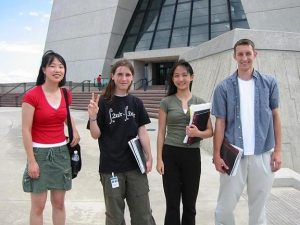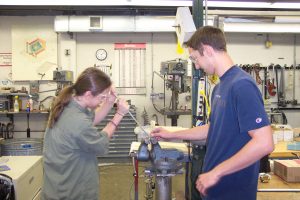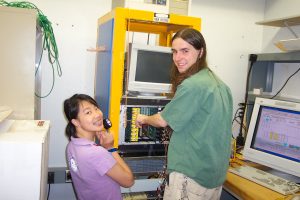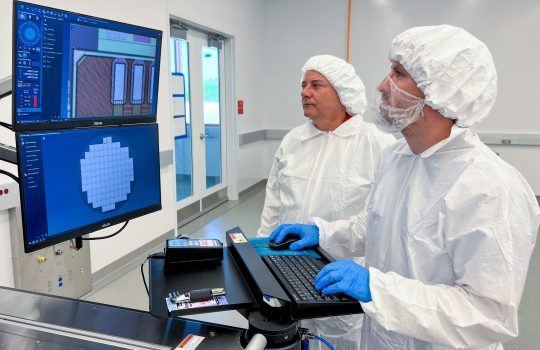
(left to right) Julia Ye, Paul Bierdz, Ting Wu and Phil Buksa have spent much of their summer vacation learning about life as a young Fermilab researcher.
BATAVIA, Illinois – Inaugurating a new phase of the QuarkNet education program, four local high school students spent eight weeks soldering electronic equipment, writing code for computer programs, analyzing data from particle physics experiments, standing shifts in a particle detector control room, attending lectures and collaboration meetings, and experiencing the real-life environment and challenges of scientists at the U.S. Department of Energy’s Fermi National Accelerator Laboratory.
“They basically did everything that a first-year graduate student researcher would do here at Fermilab,” said physicist Don Lincoln of the DZero detector experiment, who coordinated activities for the four students, along with physics teacher Dan Rubino of Glenbard North (Ill.) High School, who has participated in QuarkNet for four years.
Lincoln said two students working on an expansion of the experiment’s analysis discovered something that was not correct in the original results, while working on their own initiative. The other two students adapted DZero experimental results into Excel, to illustrate physics principles taught in high school, such as conservation of momentum; or to carry out analysis of actual experimental data.
Of the four students, one–Phil Buksa–will attend the University of Notre Dame in the fall as a physics major. Buksa, 18, a resident of Carol Stream, recently graduated from West Chicago High School as valedictorian. He has found the Fermilab environment to be unique.
“The daily environment was an extremely hard-working and diverse (did I mention intelligent?) group of people who all work together, endeavoring to better understand the fundamental nature of our universe,” said Buksa, who is also an Eagle Scout. “Where else can one attend lectures on relativity during a lunch break? Or stop testing power supplies to engage in thought experiments with an extremely intelligent and interesting electrical engineer? Whether it’s from a post-doc or from a fellow intern, I tend to learn something new about computers, or physics, or just life, everyday.”
The other three students attend the Illinois Math and Science Academy in Aurora, Illinois. All will complete their summer stay at Fermilab on Friday, August 6.
Julia Ye, 17, will return to IMSA in the fall for her senior year. The resident of Peoria, Illinois was especially intrigued by her work in Excel programming with DZero engineer Bob Angstadt, tackling problems in Visual Basic for Applications (VBA).
“Bob was kind enough to start me off with some code,” Ye said. “He was also very helpful when I couldn’t figure out how to make Excel do stuff and he gave me some subroutines he had written earlier to help me out. I went through his code line by line to learn VBA, and now I know how to use it well enough to learn on my own.”
Ye has also found some unexpected personal reward in her work.
“Just last weekend,” she said, “my dad was having some troubles with a few lines of VBA he had written and I was able to say, ‘Dad! I can help you this time!'”
Ting Wu, who resides in Elmhurst, will return to IMSA as a junior in the fall. Just 16, she was especially impressed by the people who make the process work in producing scientific results.
“We learned that mistakes are not dead ends, but simply stepping stones,” Wu said. “Furthermore, by sitting alongside shifters in the control room, we interns realized just how much work and cooperation goes into the keeping the accelerator running. I think we all stand in awe at the incredible technology needed to probe the secrets of the universe. But more than that, we are astounded by the beauty and simplicity of the particles that define our existence.
Paul Bierdz, a 2004 graduate of IMSA, will attend the University of Illinois at Urbana-Champaign as a physics major. Bierdz, 18, who resides in Oak Lawn, found his Fermilab summer to be the embodiment of a dream.
Most childhood fantasy occupations involve some aspect of emergency responders, such as a fireman,” Bierdz said. “However, I dreamed of being a scientist. This summer I worked alongside them and was accepted into their posse. I wrote analysis code, however primitive, that I used to attempt to explain how our universe operates on a fundamental level. What I’ll take away is just a taste of the future I hope to have.”
This newest phase of QuarkNet, using the tools of particle physics to instruct high school students, is funded by the National Science Foundation. QuarkNet teachers have joined research efforts of physicists at local universities or research laboratories at 52 US locations since 1999. When the teachers return to their classrooms, their students learn fundamental physics as they analyze live online data and participate in inquiry-oriented investigations.
In this new phase, students must be nominated by a QuarkNet-trained teacher affiliated with research groups at Fermilab and/or the University of Illinois. Lincoln said choosing the best of the 15 applicants might have been the greatest challenge in establishing the program.
“They were all extraordinary,” Lincoln added. “I’m glad I didn’t have to compete with them. These kids were amazing.”
Fermi National Accelerator Laboratory is operated by Universities Research Association, Inc., under contract with the Office of Science-U.S. Department of Energy.
For more information on QuarkNet and the Fermilab Education Office:
http://www-ed.fnal.gov/ed_home.html
For more information on National Science Foundation education programs:
http://www.nsf.gov/home/ehr/





